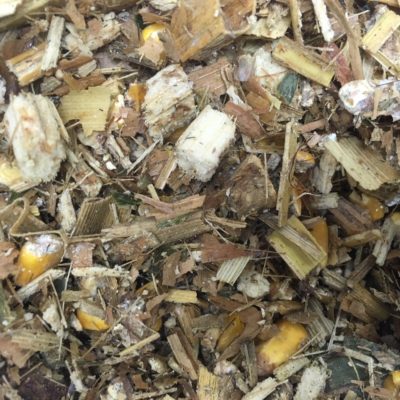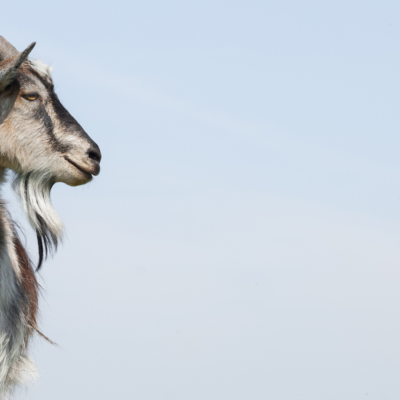Soil microbes are all the buzz these days, but what about rumen microbes? Currently, it is very common to go to a ruminant nutrition meeting and hear about feeding the microbes first. This is especially the case with the NRC Nutrient Requirements of Beef using the microbial protein and bypass protein system. There are four groups of microbes that can be found in the largest compartment of the four-chambered stomach, the rumen. These groups are bacteria, protozoa, fungi, and archaea. These microbes make up a diverse microbial community that behaves synergistically to prevent feedback end-products of fermentation, and to ensure rapid fermentation and digestion of feed. Understanding how these microbes perform and interact in the rumen can help producers to understand why certain feeds have the effects that they do in the rumen, for example why acidosis or bloat is more likely to occur on certain diets and how a step-up ration can help prevent these digestive issues.
Bacteria are small in size and replicate quickly making them the most populous microbe in the rumen at about 100,000,000,000 cells / mL of rumen fluid. Therefore, they play an important role in ruminal fermentation.
Cellulolytic bacteria are important to the breakdown of the fibrous structure of the plant material. They adhere to forages to avoid predation by other microbes and utilize cellulase, a membrane bound enzyme, to breakdown plant fibers. Populations of cellulolytic bacteria are highly affected by rumen pH. On high forage diets, lots of ruminating is needed to breakdown the feed into small particle sizes for fermentation resulting in lots of buffering saliva present in the rumen allowing cellulolytic bacteria to thrive. On high grain diets, cellulolytic populations decline as pH decreases and the rumen becomes more acidic. Important species of cellulolytic bacteria include Fibrobacter succinogenes, Ruminococcus albus, and Ruminoccuc flavefaciens.
Hemicellulolytic bacteria degrade hemicellulose into sugars, which can be used as a substrate of fermentation by other microbes in the rumen. Most Ruminococcus bacteria fall into this category.
Amylolytic bacteria can utilize ammonia as a nitrogen source, and amylase, a secreted enzyme, to breakdown starches. Like cellulolytic bacteria, their populations are also regulated by pH. Inversely to cellulolytic bacteria, amylolytic bacteria are more prevalent on a high grain diet and decline with increasing pH and rumen buffers. Amylolytic bacteria produce lactic acid which sometimes results in lactic acidosis. Streptococcus bovis is an important species of amylolytic bacteria.
Intermediate acid utilizing bacteria are also very important to rumen fermentation. These species utilize lactic acid, and succinyl acid as a fermentation substrate. Intermediate acid utilizing bacteria are key to adaptation to high grain diets, however their reproductive rate is significantly slower than other bacteria, making production management such as backgrounding or implementing a step-up ration that much more important in the prevention of acidosis. Important species of intermediate acid utilizing bacteria are Megasphaera elsdenii and Selenomonas ruminantium.
Proteolytic bacteria are very important in the rumen as they breakdown protein into peptides, amino acids and ammonia for growth by other rumen microbes. They also produce branched chain fatty acids which stimulate the growth of cellulolytic bacteria. Some important proteolytic species are Peptostreptococcus and Clostridia.
Ureolytic bacteria only make up 5% of the rumen microbial population and are associated with the rumen wall. These bacteria can break urea into ammonia and carbon dioxide allowing other microbes to utilize the ammonia as a nitrogen source.
Lipolytic bacteria use both secreted and membrane bound lipases to breakdown fat.
Protozoa make up a smaller proportion of the rumen microbe population than bacteria, but 50% of the microbial mass due to their larger size. Protozoa cannot utilize non-protein nitrogen in the form of urea or ammonia. They also predate smaller microbes such as the bacteria discussed above. Most protozoa digest non-structural carbohydrates such as sugars and starches. They play a role in acidosis prevention by sequestering some starch away from amylolytic bacteria. There are two classes of protozoa associated with fiber digestion.
Holotrichs have a long replication time, and are very sensitive to low pH, acidic environments. Therefore, exist mainly on a high forage diet and are not present in animals fed a high grain diet.
Entodiniomorphs have a short replication time and a greater population than Holotrichs. They are also more tolerant of low pH environments. Therefore, Entodiniomorphs are present in the rumen on a high grain diet but are less prevalent.
Fungi have very low populations in the rumen but are very important to fiber digestion. Fungi utilize their hyphae to physically separate strands of fiber. Picture the stem of a mushroom as the hyphae and the log it is growing out of as the cellulose bundle it is breaking down. Fungi also produce cellulase, an enzyme for breaking down the fibrous portion of the plant.
Archaea are not very populous in the rumen, but their impact on the efficiency of fermentation is very important. Archaea are the major methanogen producers in the rumen. They utilize hydrogen produced by cellulolytic bacteria to produce methane gas, which is eructated by the animal. This eructation, is considered an air pollutant by staunch environmentalists and a source of decreased production efficiency by producers. The ionophore Monensin can be utilized to decrease methanogen numbers. Important species of archaea are Methanobrevibacter and Methanomicrobium.
The four groups of microbes present in the rumen, bacteria, protozoa, fungi and archaea, play a major role in how ruminants utilize various feeds especially forages and high starch concentrate. An understanding of microbial roles and interactions in the rumen can help a producer understand the importance of feed testing when formulating a new ration, changing the ruminant’s diet from forage-based to grain-based, and preventing acidosis or bloat.





[…] incidence of acidosis and bloat. Here are how 7 feed additives modify rumen metabolism and fermentation process in the rumen to prevent bloat and […]
[…] from belching. Ruminants, including beef cattle, bison, sheep and goats, have a large population of gut microbes which produce methane gas as a by product. Grass fed-beef produces more methane as a byproduct to […]